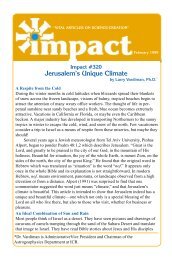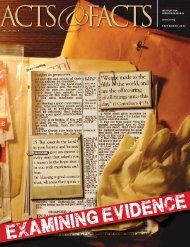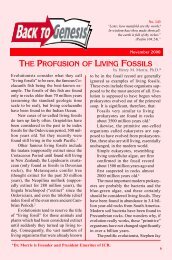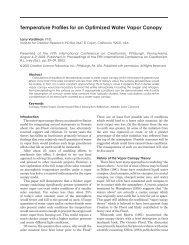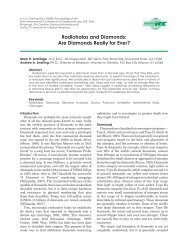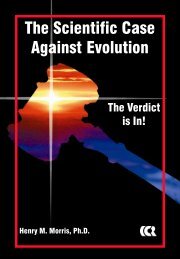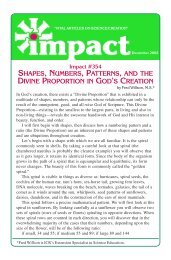Accelerated Decay: Theoretical Models. - Institute for Creation ...
Accelerated Decay: Theoretical Models. - Institute for Creation ...
Accelerated Decay: Theoretical Models. - Institute for Creation ...
You also want an ePaper? Increase the reach of your titles
YUMPU automatically turns print PDFs into web optimized ePapers that Google loves.
V(r)I II IIIr ErV oFigure 1. The Square-Well Potential with Coulomb BarrierALPHA DECAY AND VARIATION OF THE NUCLEAR FORCE STRENGTHHistorically, the numerical treatment of alpha decay has relied on quantum mechanics and the tunnelingtheory [38, 40]. Figure 1 shows the usual scheme where the potential felt by an alpha particle is modeledby a square well <strong>for</strong> the interior of the nucleus and a Coulomb repulsion outside. Classically, a particlecould not occupy region II of the figure; thus it could not have the negative energy that would be required<strong>for</strong> it to have only a few MeV of kinetic energy when it escapes to infinity. However, a wave such as thatused in quantum theory can leak through, even though the particle would have a negative energy <strong>for</strong>radius less than the r E value shown in the figure.Although the changes in physical “constants” suggested in recent physics literature are very small [11],alpha decay rates are very sensitive to small changes in well depths or shapes. At the 1994 InternationalConference on <strong>Creation</strong>ism , Chaffin [12] discussed results of a numerical study, using a simplecomputer program, which allowed the depth of the nuclear potential well to vary. The radius of thenucleus and the depth of the potential well represent two variables which are tied to the energy of theemitted α-particle and the decay constant. In this simple model a constraint is needed, which may betake to be the approximate constancy of radioactive halo radii [11, 22, 30, 44]. If the energy of the α-particle is held constant, then the halo radius will also be constant. Since the radius of a halo ring isslightly dependent on the dose of radiation and the size of the halo inclusions, an exact constraint on theα-particle energy cannot be maintained. For a 5 MeV change in the potential well depth, with the α-energy held exactly constant the computer program showed that the decay constant will change by onlyone power of ten. If the α-energy is allowed to change by 10% or so, then the decay constant changesby about 10 5 . If the accelerated decay needed to explain the data is restricted to about one year or so,then a change in the decay constant of 10 9 or so may be required [14]. Thus these considerationsseemed to indicate that a one-year episode of accelerated decay at the time of the Flood may not beenough.To test the variability of the decay constant, the computer program mentioned above, which was aFortran program, was rewritten using Mathematica, a very powerful, modern software package whichfacilitates numerical work of this sort. For the square well potential on the inside of the nucleus, theMathematica notebook gave essentially the same answers as the earlier work. In collaboration withGothard and Tuttle [9], Chaffin modified the notebook to use a harmonic oscillator potential <strong>for</strong> theinterior region, where the nuclear potential is felt by the alpha particle. In the course of this work, it wasdiscovered that, as the nuclear potential well depth is changed, and the nuclear radius changes slightly, itis possible to have a sudden change in the number of nodes of the real part of the alpha particle'swavefunction. This was modeled <strong>for</strong> both the harmonic oscillator and square well potentials, with nearlythe same results <strong>for</strong> either notebook.
Figure 2. Sudden change in the number of nodes. The harmonic oscillator wave function <strong>for</strong> well depthsof 58 MeV (a) and 54 MeV (b). The x-axis is the radial coordinate of the alpha particle, T=ρ/(2η), where ρand η are defined in Green and Lee [26]. Figure 2a shows the harmonic oscillator wave function <strong>for</strong> awell depth of 58 MeV. Figure 2b shows what happens when the well depth is changed to 54 MeV,without changing the alpha particle energy. If one counts the number of nodes in Figure 2a, there arenine, not counting the ones at zero and infinity. For Figure 2b, there are eight nodes, a reduction by one.Figure 3. The decay constant versus well depth <strong>for</strong> the harmonic oscillator interior potential. The graphshows a discontinuity, which occurs when the wavefunction changes the number of nodes as the radiusslowly increases.The change in the number of nodes causes the probability of tunneling to change by about a factor often, as shown by the discontinuity in the graph of Figure 3. Tunneling probabilities depend on the size ofthe wavefunction at infinity. The two graphs of Figure 2a,b show the wavefunction decreasing to zero atinfinity. However, the probability of alpha decay <strong>for</strong> a nucleus such as uranium-238 is very low, hence thewavefunction will have small oscillation of both its real and imaginary parts, too small to show on thisscale. Figure 4 shows a plot of the real part of the wavefunction <strong>for</strong> well depth parameter of 54, done withMathematica. The x-axis shows a dimensionless variable T (defined in [21]), whose size represents thedistance from the nucleus.
Figure 4: The real part of the Coulombic wavefunction outside the Coulomb barrier. The oscillatorybehavior shows that the probability of escape is not zero <strong>for</strong> the alpha particle. The x-axis is thedimensionless radial coordinate ρ defined in Green and Lee [26].The use of potentials with a sharp boundary between the interior and exterior of the nucleus is notrealistic. Consequently, In collaboration with Daniel Banks [7], a Mathematica notebook was written touse the exponentially diffuse boundary square well <strong>for</strong> the interior of the nucleus. This interior potentialwas originally investigated in a classic work by Green and Lee [26], although they did not apply it toalpha decay. Figure 5 shows the potential well and the corresponding wavefunction <strong>for</strong> this case.Figure 5: The Exponentially Diffuse boundary potential and the corresponding wavefunction. The verticalaxis is energy in MeV and the horizontal axis is the radius ρ. For the wavefunction, the vertical axis is thereal part of the wavefunction multiplied by ten.The use of this potential allows the potential energy to increase gradually as the distance increasesoutward and the nuclear <strong>for</strong>ce yields to the Coulomb repulsion. The treatment is somewhat complicated,in that now the wavefunction is a spherical Bessel function on the interior of the well, whose logarithmicderivative is matched to a Bessel function of nonintegral order <strong>for</strong> the changeover region, and then to aCoulomb wavefunction <strong>for</strong> the exterior region. There is now an interior radius <strong>for</strong> the changeover region,as well as an exterior radius. Either one can be varied to see what the effect is. In summary, it is foundthat the size of the variations is about what we obtained <strong>for</strong> the simpler cases of the square well orharmonic oscillator well.The depth of the nuclear potential well is determined directly by the strength of the strong nuclear <strong>for</strong>ce,hence by the “strong coupling constant.” A coupling constant is a number inserted in a theory to fix thestrength of a <strong>for</strong>ce. We determine it experimentally, but theories exist which indicate that it may not be aconstant over the history of the universe. Hence, we will discuss the relevant parts of these theories inthe next few sections.TOPOLOGY AND STRINGSMultidimensional string theories quickly lead to the branch of mathematics known as topology. This, ofnecessity, is what happens when one takes these extra coordinates, or dimensions, seriously. An n-dimensional manifold is a space which can be trans<strong>for</strong>med into a connected polyhedron, and such thatevery point can be surrounded by a collection of other points which is equivalent to the interior of an n-dimensional ball [2, 35, 39]. For example, the surface of a sphere is a two-dimensional manifold, whichmathematicians write as S 2(pronounced S-two, not S-squared). One needs two numbers to specify apoint on this manifold, hence the number 2 means it is two-dimensional. Another two-dimensionalmanifold is the surface of a torus, T 2 . For precise, mathematical purposes, the sphere S 2 and the torus T 2are distinct entities, and should not be confused.
CirclexLinexFigure 6. The position of a pendulum bob, confined to move in a single vertical plane, can be completelyspecified by a single linear coordinate x, provided the pendulum does not swing over the support's level.If the pendulum is free to swing higher than the support, then the circular topology is needed to specifythe position. (Figure drawn after Rourke and Stewart, [41]).For example, suppose we are trying to describe the motion of a pendulum (Figure 6). Initially, let ussuppose that the pendulum is swinging back and <strong>for</strong>th, staying perfectly within the confines of a verticalplane. Then we could draw a line, or projection, down to the point on a flat, horizontal surface directlybelow the pendulum ball. A single coordinate x would then suffice to specify the position of the pendulumball, this coordinate specifying the position on a straight line. However, <strong>for</strong> large oscillations of thependulum, and if the pendulum was fixed by a universal joint at the top, the pendulum could swing overthe top. Our single coordinate would then not suffice to distinguish positions above the support frompositions below the support. Hence, a more correct mathematical model <strong>for</strong> the pendulum would be thecircle. If, in addition, the pendulum were now able to swing in all directions, and not confined to onevertical plane, then the circular topology becomes inadequate, and a more correct model is the sphere,S 2 .Suppose now that the problem is that of two pendulums, each confined to move in a vertical plane butallowed to swing over the top. The two pendulums move independently of each other, assumingpositions on two different circles. The combined coordinates now have a different topology, the topologyof the torus, T 2 .One of the early pioneers of topology was Henri Poincaré, whose active work on the subject occurredduring the 1890's up to his death in 1912. Poincaré analyzed different surfaces by thinking in terms ofde<strong>for</strong>mations of loops, which links to what are now called homology and homotopy. In mathematicaltopology, homology theory concerns itself with the question of the number of holes in the space. Shownin Figure 7 are three curves, a, b, and c on the surface of a torus. The curves a, b, and c have somethingin common, they cannot be shrunk to a point by continuous sequence of de<strong>for</strong>mations. For curves a andb it is because the hole is there. For curve c it is because the curve is wound around a closedcircumference and cannot be shrunk unless one cuts the curve, moves it, and then pastes the endstogether. In topology, this is described by stating that a and b belong to the same homology class,whereas c belongs to a different class. Similarly, the concept of homotopy concerns itself with de<strong>for</strong>mingloops. Two loops are homotopic if they can be continuously de<strong>for</strong>med into each other. These concepts,and others, become important tools in analyzing topology and ultimately multidimensional string theory.
abcFigure 7. Three closed curves on the surface of a doughnut (torus) illustrate inequivalent and equivalentclosed paths. Curves a and b, which bound the hatched area, can be smoothly distorted into each other,whereas curve c winds around a different direction and cannot be distorted into a or b, without cuttingand pasting the ends (Figure drawn after Eguchi, Gilkey and Hanson, [20]).Within the last five to ten years research has uncovered numerous dualities relating different limits and<strong>for</strong>mulations of string and membrane theories. Greene [27, pp. 231-262] and Duff [19] have discussedthe duality between ordinary vibrational modes and winding modes of a string (see Figure 8).ordinary vibration modeswinding modesFigure 8. The ordinary vibration modes of closed strings (above) and the winding modes (below). In theequations of string theory, these two modes carry energy, and exchange roles when the radius of thecompactified dimension moves from small to large.A value of the radius <strong>for</strong> compactified dimensions leads to the same results or equivalent results <strong>for</strong> adifferent radius, in which the winding modes and ordinary vibrational modes change roles in theequations of the theory [13]. Another type of duality relates the strong coupling limit of one theory to theweak coupling limit of another. A coupling constant is a number giving the strength with which anelementary particle is coupled to the field that it experiences. For example the coupling constant <strong>for</strong>interaction with the electromagnetic field is the electric charge. In some work by Witten [49] and Lykken[34], these authors was speculated that, contrary to previous thought (see Kaplunovsky, [32,33]), strongcoupling limits of certain string theories were more relevant to accelerator physics. This led to some morerealistic applications of string theory than had been previously been possible (see Nath and Yamaguchi,[36]).
Candelas and Weinberg [6], and be<strong>for</strong>e them Rubin and Roth [42], attempted to extrapolate from theparallel-plate case to a realistic Kaluza-Klein model. Such a model would remove the artificial constraintsof an assumed external geometry and an assumed time-independent internal geometry. Realistic modelswould also involve more than just one compact dimension with compactification brought about byvacuum expectation values (VEV's) <strong>for</strong> non-gravitational fields, and would include fermionic (half-integralspin) fields. The presence of curvature in both the compact and non-compact dimensions, the responseof the VEV's to changes in temperature, and fermion degeneracy pressure might well all contribute tobehavior very different from that observed in the parallel-plate case.This idea provides a possible mechanism <strong>for</strong> changing the radii of the compact dimensions as theuniverse expands and its background temperature changes. Early in creation week, it may be that themechanism could also work in a young-earth model.KALUZA-KLEIN EXCITATIONSIn superstring theory, we need to link a 10-dimensional "manifold," which is simply a framework whichcan be smoothly described by 10 independent coordinates, with our observed four-dimensionalspacetime. If the extra six dimensions are curled up into a compact space, this simply means that everypoint of four-dimensional spacetime has one of these compact six-dimensional spaces associated with it(In more recent theory, 11 dimensional membranes are wrapped up to make ten-dimensionalsuperstrings, but that is just an unneeded complication as far as we will be concerned.). If the size of thecompactified six-dimensional space is small compared to the scale of everyday life, we would not directlydetect the effect of these extra dimensions [10, 29].At high enough energies, higher even than those of the abortive superconducting supercollider, the SSC- which began but did not complete construction in Texas, a particle accelerator would be likely to detectthe presence of the so-called Kaluza-Klein excitations or Kaluza-Klein modes. In quantum mechanics,waves are associated with all particles. When we consider string theory, we find that if a spatialdimension is curled up, then the momentum p associated with the waves wrapping around thisdimension will be quantized, with values p = nh/(2πR), n = 0,1,2,3, . . . , and h is Planck's constant, whileR is the radius of the compactified dimension. In this picture the masses of the quantized excitations, themasses m nof the particles, are given by m n2= m02+n2h2/(4π 2 R 2 c 2 ), where m 0is the mass of the modewith zero momentum and c is the speed of light.Particles can be divided into fermions (half-integral spin) and bosons (integral spin). It is possible that thefermions or some of the fermions may not have Kaluza-Klein excitations [15]. This is dependent onexactly how the extra dimensions are compactified. If the fermion corresponds to excitations located atthe fixed points of an orbifold, then no Kaluza-Klein excitations exist. In mathematically precise<strong>for</strong>mulations of topology, an orbifold is a way of smoothing over or "blowing up" certain fixed points atwhich different coordinates must be joined [18].In the actual multidimensional string theories, we need to make contact with the "real" world of fourspacetime dimensions. The 10-dimensional superstring theory must compactify six of the dimensions ona six-dimensional compact manifold. Particle physicists have, in the last 15 years, spent a great deal oftime studying just how to do this. Fortunately, mathematicians have been studying topology since thetime of Poincaré in the late 1800's. While they have not fully developed all the machinery needed by thestring theorists, two mathematicians, Eugenio Calabi and Shing-Tung Yau had studied a type of sixdimensionalspace, known as a Calabi-Yau space (pronounced cah-lah'-bee-yah'-oo) which particletheories needed [27]. The topology of this space, with the requisite number of "holes," seems to be rightto allow the known quarks and leptons to be described in terms of string theory. The quarks and leptonsare grouped into three "families," which are allowed by these Calabi-Yau shapes. They allow descriptionin terms of representations of the SU(3)×SU(2)×U(1) group of the so-called standard model.UNIFIED THEORIESIn 1974 the SU(5) theory of combined strong, weak, and electromagnetic interactions was proposed (seeGeorgi and Glashow, [25] and Georgi, Quinn, and Weinberg, [24]). The SU(5) theory receives its namebecause it is modeled after five by five special unitary matrices (hence the nickname SU standing <strong>for</strong>special unitary), special meaning they have determinant plus one. This theory allowed all the families ofquarks and leptons to be combined into representations of the SU(5) group, which means that we only
needed particles called gluons, W + , W - , Z 0bosons, and the photon to describe the <strong>for</strong>ces between thequarks and leptons (Georgi [23] has given a popular-level description of how this theory was<strong>for</strong>mulated.). Basically, the SU(5) theory had only one "coupling constant." In accord with previousdiscussion, "coupling constant" may be thought of as a number which describes how much <strong>for</strong>ceoriginates from placing particles of known type a certain distance apart. Each type of <strong>for</strong>ce has its owncoupling constant, but the SU(5) theory implied that the coupling constants <strong>for</strong> strong, weak andelectromagnetic <strong>for</strong>ces all originated from a single constant, diverging into their various values as theenergy of the interactions is lowered from high energies down to low energies. The reason <strong>for</strong> thedivergence of these values has to do with what is called renormalization, and with the effective fieldtheory which results from per<strong>for</strong>ming the renormalization appropriate to a given energy scale. In quantumfield theory, a particle is surrounded by a cloud of virtual particles, which cloud will be penetrated tovarying degrees by a second particle interacting with it [23]. A more energetic particle penetrates further.For example, a real particle with positive electric charge will be surrounded by pairs of virtual electronsand positrons. On the average, the virtual positrons are pushed farther away from the real particle, whilethe virtual electrons are nearer to it. So on the average, the real particle has more negative charge nearto it than far from it. A second real particle, depending on its energy, will penetrate this cloud to a lesseror greater degree. For this reason, the effective interaction depends on the particle energy, and thecoupling constant of electromagnetic interactions is less <strong>for</strong> smaller energies. In the case of the strong<strong>for</strong>ce, the gluons cause the <strong>for</strong>ce to get weaker at larger energies [23, p. 432].Renormalization theory says that not only the coupling constants, but also the masses of particlesappear to vary on different energy scales [37]. While quantum theory connects this effect to varyingenergy scales, the basic ideas are actually much older. J.J. Thomson discovered the so-calledelectromagnetic mass in 1881 [45]. Thomson correctly noted that a charge moving through a dielectricexperiences a resistance, which is non-dissipative, and hence is best described by an additionalcontribution to the mass. The resistance is comparable to that of a sphere moving through a perfect fluid.Motion of the sphere is impeded by the presence of the fluid. Using James Clerk Maxwell's theory ofelectricity and magnetism, Thomson showed that the charged sphere, moving through the dielectric,would experience an additional mass. Thomson's equation <strong>for</strong> the new mass m is:4 µ0em= m 0+15 awhere e is the charge, a is the radius of the sphere, and µ 0is the magnetic permeability. While quantumtheory does not assign a radius to the electron, the "vacuum polarization" effect is nevertheless a realeffect [23, p. 434], [5, section 8.2]. In many lab experiments, the particles have low energy and arenowhere near the large energies that bring out these effects. However, <strong>for</strong> experiments involving modernparticle accelerators, these effects become evident: the effective coupling constants and effectivemasses vary with energy.The SU(5) theory of Georgi and colleagues had an un<strong>for</strong>tunate failure. It predicted the decay of theproton, with a half-life greater than 10 29 years. As a result of this prediction, experiments were set up todetect this proton decay, and no conclusive evidence <strong>for</strong> such decays was found. The half-life of theproton, if not infinite, was shown to be higher than the range which the SU(5) theory seems to allow.Other unified theories based on other groups or on string theory are possible, and this is still an activefield of research. For example, Shiu and Tye [43] discussed the possible suppression of proton decay byan additional symmetry, while Dienes, Dudas, and Gherghetta [16,17] discussed a higher-dimensionalmechanism involving selection rules <strong>for</strong> the Kaluza-Klein excitations which allow all proton-decayprocesses to have vanishing probability. In the SU(5) theory and in similar theories allowing protondecay, there are particles, either X-bosons or Higgs particles, which are responsible <strong>for</strong> the proton'sdecay. In the Dienes, Dudas and Gherghetta theory, however, the proton does not have Kaluza-Kleinexcitations which leads to a zero probability <strong>for</strong> its decay (Technically, the proton is said to be restrictedto the fixed points of an orbifold, at which point the probability <strong>for</strong> interacting with the X-bosons or Higgsparticles is zero.). Of course, these theories are untested at present, so the correct explanation <strong>for</strong> thelack of proton decay is still undecided.Un<strong>for</strong>tunately, this also leaves open the question of whether or not the SU(5) theory was correct inpredicting that there is only one coupling constant at high energies. If the radii of compactifieddimensions varied over the early history of creation, then a related question also seems to beunanswered <strong>for</strong> us. Could the rates of alpha and beta decay vary relative to each other over the historyof the universe? This is an interesting question, and needs to be answered in order to correctly interpretradioisotope data A start in this direction will be provided in the next section.2(3)
KALUZA-KLEIN EXCITATIONS AND THE FERMI COUPLING CONSTANTNath and Yamaguchi [36], considered the question of whether Kaluza-Klein excitations contribute to theso-called Fermi constant, which determines the fundamental rates of beta decays. Enrico Fermi, theItalian-American of the Manhattan project, was responsible <strong>for</strong> the first realistic theories of beta decay, sothis coupling constant G F, as applied in beta decay theory, is named after him. For the case of one extradimension, Nath and Yamaguchi showed that to leading order in the ratio of the W boson mass M Wto themass proportional to 1/R (the compactification scale mass M R), the effective Fermi constant G eff is givenFbyGeffF2 2SMπ MW≅ GF( 1+2 )3 MSMHere, G Fis the value of the Fermi constant, which may be calculated from the standard model ofquantum field theory (Nath and Yamaguchi [36] comment that the standard model agrees very well withexperiment) without any assumptions about extra dimensions. For the case of more than one extradimension, Nath and Yamaguchi derived a simple <strong>for</strong>mula similar to the above but depending on theextra dimensions. From the results of standard model calculations, plus experimental measurements [1,46], Nath and Yamaguchi showed that the energy M Rc 2 was at least 1.6 TeV. This encourages particlephysicists to hope that, with the completion of the Large Hadron Collider (LHC), expected in 2006 or so,evidence <strong>for</strong> these extra dimensions may be found (see Kane [31] <strong>for</strong> a semi-fictitious account ofexpectations).Now, because we are interested in the possibility of accelerated decay in the early universe, we need totake the discussion a step further than Nath and Yamaguchi did. In their paper, they only consideredpresent-day measurements. Because of our interest in explaining radioisotope data in terms of a youngearth, we may think as follows. If, over the early history of the universe, the radius of compactdimensions should change, then so would the mass scale M R, and hence the value of the Fermiconstant. Under the simplifying assumption that other factors in the equation do not change as radicallyas M Rdoes, decreases in the sizes of extra dimensions would increase M R, and hence decrease thevalues of G F. This in turn would mean that half-lives <strong>for</strong> beta decays of nuclei would become larger as theextra dimensions became smaller. Thus, one would expect accelerated decay to have occurred early inthe history of the creation.CONCLUSIONA straight<strong>for</strong>ward biblical interpretation does not rule out a period of accelerated decay early in creationweek. Since life does not appear until some time on day three, the cessation of the accelerated decay atthat point prevents life from receiving abnormally large radiation doses. The models presented dependon the compactification of extra dimensions, with the compactification being completed early in creationweek. Other models may lead to accelerated decay at other points, <strong>for</strong> instance during the Fall ofGenesis 3 or during the Flood of Noah, but it would seem that these other episodes would probably haveto be explained using alternative models, and could not allow as much accelerated decay as could beaccommodated early in creation week.Since God is the origin of physical principles, it would be wrong to state that He must act in a certainway. However, Scripture is a reliable record of His actual creation. The models considered here merelypoint out some unnecessary assumptions involved in interpreting radioactive decay: half lives may nothave been constant.Although extended Kaluza-Klein and string theories must be considered as highly tentative theories, inthis work we find some explicit equations showing the variation of the Fermi constant. These resultsenable one to conjecture about how much the variation must have been in order to explain present-dayisotopic abundances. Since there is no precise number to match with theory, and since variousapproaches to the final, present-day abundances are possible, these results remain explanatory innature. Perhaps future studies will be able to connect more precisely with the data.ACKNOWLEDGEMENTSThe author has benefited from a research grant from the Radioisotopes and the Age of the Earth (RATE)project, sponsored by the <strong>Institute</strong> <strong>for</strong> <strong>Creation</strong> Research and the <strong>Creation</strong> Research Society. I thank thedonors to the project. I also thank the reviewers of this paper.R(4)
REFERENCES[1] Abachi et al. (D0 collaboration), Search <strong>for</strong> right-handed W bosons and heavy W' in p-pbarcollisions at √s = 1.8 TeV. Physical Review Letters 76: (1996) 3271-3276.[2] Alexandroff, P., Elementary concepts of topology, 1961, Dover. New York.[3] Antoniadis, I. and M. Quirós, Large radii and string unification, Physics Letters B 392, (1997) 61-66.[4] Arkani-Hamed, N., S. Dimopoulos, and G. Dvali, The hierarchy problem and new dimensions at amillimeter, Physics Letters B 429, (1998) 263-272.[5] Bjorken, J.D. and S.D. Drell, Relativistic quantum mechanics, 1964, McGraw-Hill, New York.[6] Candelas, P. and S. Weinberg, Calculation of gauge couplings and compact circumferencesfrom self-consistent dimensional reduction, Nuclear Physics B 237, (1984) 397-441.[7] Chaffin, Eugene F. and Daniel S. Banks, A Mathematica Program Using Exponentially DiffuseBoundary Square Well Eigenstates to Model Alpha-Particle Tunneling Half Life Variability, (2002)nucl-th/0206020.[8] Chaffin, E.F., A model <strong>for</strong> the variation of the Fermi constant with time. <strong>Creation</strong> ResearchSociety Quarterly 38:3 (2001) 127-138.[9] Chaffin, Eugene F. Nicholas W. Gothard, Joshua Tuttle, A Mathematica Program Using IsotropicHarmonic Oscillator Eigenstates to Model Alpha-Particle Tunneling Half Life Variability, (2001)nucl-th/0105070[10] Chaffin, E. F., A mechanism <strong>for</strong> accelerated radioactive decay. <strong>Creation</strong> Research SocietyQuarterly 37 (2000) 3-9.[11] Chaffin, E.F., <strong>Theoretical</strong> mechanisms of accelerated radioactive decay, Radioisotopes and theage of the earth., L. Vardiman, A.A. Snelling and E.F. Chaffin, editors, 2000, <strong>Institute</strong> <strong>for</strong> <strong>Creation</strong>Research and <strong>Creation</strong> Research Society, Santee, CA. pp. 305-331.[12] Chaffin, E. F., 1994. Are fundamental "constants" of physics really variables? Proceedings ofthe Third International Conference on <strong>Creation</strong>ism, 1994, <strong>Creation</strong> Science Fellowship, Inc. pp. 143-150.[13] Dai, J., R.G. Leigh, and J. Polchinski, New connections between string theories. Modern PhysicsLetters A4 (1989) 2073-2083.[14] DeYoung, Don, Radioisotope dating review., Radioisotopes and the age of the earth, L. Vardiman,A.A. Snelling, and E. Chaffin, editors, 2000, <strong>Institute</strong> <strong>for</strong> <strong>Creation</strong> Research and <strong>Creation</strong> ResearchSociety, El Cajon, CA. Chapter 2.[15] Dienes, K. R., E. Dudas, and T. Gherghetta, Grand unification at intermediate mass scalesthrough extra dimensions. Nuclear Physics B 537 (1999) 47-108; hep-ph/9806292.[16] Dienes, K. R., E. Dudas, and T. Gherghetta, TeV-Scale GUTs, (1998) hep-ph/ 9807522[17] Dienes, K. R., E. Dudas, and T. Gherghetta, Extra spacetime dimensions and unification.Physics Letters B 436 (1998) 55-65.[18] Dixon, L., J. A. Harvey, C. Vafa, and E. Witten, Strings on orbifolds. Nuclear Physics B 261 (1985)678-686.[19] Duff, M.J., The theory <strong>for</strong>merly known as strings. Scientific American 278:2 (1998) 64-69.[20] Eguchi, T., P.B. Gilkey, and A.J. Hanson, Gravitation, gauge theories and differential geometry.Physics Reports 66 (1980) 213-393.[21] Fröberg, C.-E., Numerical treatment of coulomb wavefunctions, Reviews of Modern Physics 27:4(1955) 399-411.[22] Gentry, Robert V., <strong>Creation</strong>'s tiny mystery, 1992, Earth Science Associates, Knoxville, TN.
[23] Georgi, H. M., Grand unified theories, The New Physics,. Davies, Paul, Editor, 1989, CambridgeUniversity Press. New York and Cambridge, pp. 425-445.[24] Georgi, H., H. R. Quinn, and S. Weinberg, Hierarchy of interactions in unified gauge theories,Physical Review Letters 33:7(1974) 451-454.[25] Georgi, H. and S. L. Glashow, Unity of all elementary-particle <strong>for</strong>ces, Physical Review Letters32:8 (1974) 438-441.[26] Green, A. E. S. and K. Lee, Energy eigenvalues <strong>for</strong> a spherical well with an exponentiallydiffuse boundary, Physical Review 99:1 (1955) 772-777.[27] Greene, B., The elegant universe, 2000, Vintage Books, New York.[28] Hawking, Stephen, A brief history of time: Updated and expanded tenth anniversity edition, 1996,Bantam Books, New York.[29] Hawking, Stephen, Universe in a nutshell, 2001, Bantam Books, New York.[30] Humphreys, D.R., <strong>Accelerated</strong> nuclear decay: A viable hypothesis? In L. Vardiman, A.A. Snellingand E.F. Chaffin, Editors, 2000, Radioisotopes and the age of the earth, <strong>Institute</strong> <strong>for</strong> <strong>Creation</strong> Researchand <strong>Creation</strong> Research Society, Santee, CA. pp. 333-379.[31] Kane, G. L., Experimental evidence <strong>for</strong> more dimensions reported. Physics Today 51:5 (1998)13-15.[32] Kaplunovsky, V. S., Erratum. Nuclear Physics B 382 (1992) 436.[33] Kaplunovsky, V. S., One-loop threshold effects in string unification, Nuclear Physics B 307(1988)145-156.[34] Lykken, J. D., Weak scale superstrings, Physical Review D 54 (1996) 3693-3697.[35] Nash, Charles and Siddhartha Sen, Topology and Geometry <strong>for</strong> Physicists, 1983, Academic Press,New York.[36] Nath, P. and M. Yamaguchi, Effects of extra space-time dimensions on the Fermi constant,Physical Review D 60:11 (1999) 116004-1 to 116004-4.[37] Nelson, Philip, Naturalness in theoretical physics, American Scientist 73 (1985) 60-67.[38] Pierronne, M. and L. Marquez, On the complex energy eigenvalue theory of alpha decay,Zeitschrift für Physik A 286 (1978) 19-25.[39] Pontryagin, L.S., Foundations of combinatorial topology, 1999, Dover, New York.[40] Preston, M. A., The theory of alpha-radioactivity, Physical Review 71:12 (1947) 865-877.[41] Rourke, C. and I. Stewart, Poincaré's perplexing problem, New Scientist 112 (4 September 1986)41-45.[42] Rubin, M. A. and D. B. Roth, Temperature effects in five-dimensional Kaluza-Klein theory,Nuclear Physics B 226 (1983) 444-454.[43] Shiu, G. and S.-H. H. Tye, TeV scale superstring and extra dimensions, Physical Review D 58(1998) 106007-1 to 106007-13.[44] Snelling, A.A., Radiohalos, Radioisotopes and the age of the earth, Vardiman, L., A.A. Snelling, andE. Chaffin, Editors, 2000, <strong>Institute</strong> <strong>for</strong> <strong>Creation</strong> Research and <strong>Creation</strong> Research Society, El Cajon, CA,Chapter 8.[45] Thomson, J.J., On the electric and magnetic effects produced by the motion of electrifiedbodies, Philosophical Magazine 11 (1881) 229-249.[46] van Ritbergen, T. and R. G. Stuart, Complete 2-Loop quantum electrodynamic contributions tothe muon lifetime in the Fermi model, Physical Review Letters 82 (1999) 488-491.
[47] Weinberg, S., Charges from extra dimensions, Physics Letters B 125:4 (1983) 265-269.[48] Witten, E., Search <strong>for</strong> a realistic Kaluza-Klein theory, Nuclear Physics B 186 (1981) 412-428.[49] Witten, E., Strong coupling expansion of Calabi-Yau compactification, Nuclear Physics B 471(1996) 135-158.



